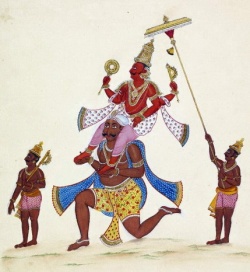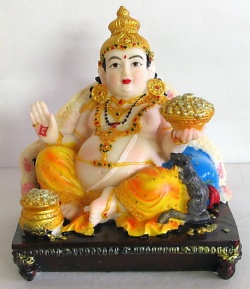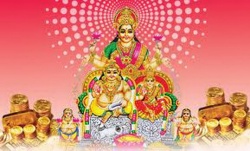Kubera Or Vaisravana, The God Of Wealth
According to Hindu mythology, Kubera was the son of a sage called "Visravas", hence his patronymic Vaisravana. He is said to have performed austerities for a thousand years, in reward for which Brahma, the Creator, gave him immortality and made him god of wealth, guardian of all the treasures of the earthh he was to give out to whom they were destined.
Kuberas abode was said to be mount Kailash; but when Brahma appointed him God of Riches, he gave him Lanka (Ceylon) as his capital, and presented him, according to the Mahabharata, with the car pushpaka, which was of immense size and "moved at the owners will at marvellous speed".
Kubera is also worshipped by the Buddhists, where he is looked upon as the guardian of the North. His characteristic symbol is the mongoose, often shown vomiting jewels. In the Buddhist pantheon he is also known as Jambhala, probably from the jambhara (lemon) he carries in his hand. He is always represented corpulent and covered with jewels. His right foot is generally pendant and supported by a lotus flower on which is a conch shell.
Vaishravana
毘沙門天・多聞天 (Skt; Jpn Bishamon-ten or Tamon-ten)
Also known as Hearer of Many Teachings. One of the four heavenly kings of Buddhist mythology, this god is said to live halfway up the northern side of Mount Sumeru and protect the northern quarter, accompanied by the two classes of demons called yaksha and rakshasa. Among the four heavenly kings, he is often regarded as foremost. Vaishravana's name was rendered in Chinese as "Hearer of Many Teachings." This god is said always to protect the place where the Buddha preaches. In the "Dharani" (twenty-sixth) chapter of the Lotus Sutra, he pledges to protect the votaries of the sutra. In Japan, as one of the seven beneficent deities, he is called Bishamon-ten. Vaishravana is known as Kubera in Hindu mythology, the king of yakshas and the god of wealth.
One of the names of Kuvera, given to him because his kingdom is called Visana (D.iii.201; SNA.i.369, etc.). He is one of the Catummaharajano and rules over the Yakkhas, his kingdom being in the north (E.g., D.ii.207). In the Atanatiya Sutta he is the spokesman, and he recited the Atanatiya rune for the protection of the Buddha and his followers from the Yakkhas who had no faith in the Buddha. D.iii.194; he was spokesman because he was intimate with the Buddha, expert in conversation, well trained (DA.iii.962).
He rides in the Narivahana, which is twelve yojanas long, its seat being of coral. His retinue is composed of ten thousand crores of Yakkhas. (SNA.i.379; the preachers seat in the Lohapasada at Anuradhapura was made in the design of the Narivahana, Mhv.xxvii.29). He is a sotapanna and his life span is ninety thousand years (AA.ii.718). The books record a conversation between him and Velukantaki Nandamata (q.v.), when he heard her sing the Parayana Vagga and stayed to listen. When Culasubhadda wished to invite the Buddha and his monks to her house in Saketa, and felt doubtful about it, Vessavana appeared before her and said that the Buddha would come at her invitation (AA.ii.483).
On another occasion (A.iv.162; on his way to see the Buddha) he heard Uttara Thera preaching to the monks in Dhavajalika on the Sankheyya Mountain, near Mahisavatthu, and went and told Sakka, who visited Uttara and had a discussion with him.
Once when Vessavana was travelling through the air, he saw Sambhuta Thera wrapt in samadhi. Vessavana descended from his chariot, worshipped the Thera, and left behind two Yakkhas with orders to wait until the Elder should emerge from his trance. The Yakkhas then greeted the Thera in the name of Vessavana and told him they had been left to protect him. The Elder sent thanks to Vessavana, but informed him, through the Yakkhas, that the Buddha had taught his disciples to protect themselves through mindfulness, and so further protection was not needed. Vessavana visited Sambhuta on his return, and finding that the Elder had become an arahant, went to Savatthi and carried the news to the Buddha. ThagA.i.46f. Just as he encouraged the good, so he showed his resentment against the wicked; see, e.g., Revati.
Mention is made of Vessavanas Gadavudha* and his mango tree, the Atulamba**. Alavakas abode was near that of Vessavana (SNA.i.240).
- SNA.i.225; the books (e,g., SA.i.249; Sp.ii.440) are careful to mention that he used his Gadavudha only while he was yet a puthujjana.
- J.iv.324, also called Abbhantaramba (see the Abbharantara Jataka).
- J.iv.324, also called Abbhantaramba (see the Abbharantara Jataka).
Bimbisara, after death, was born seven times as one of the ministers (paricaraka) of Vessavana, and, while on his way with a message from Vessavana to Virulhaka,


